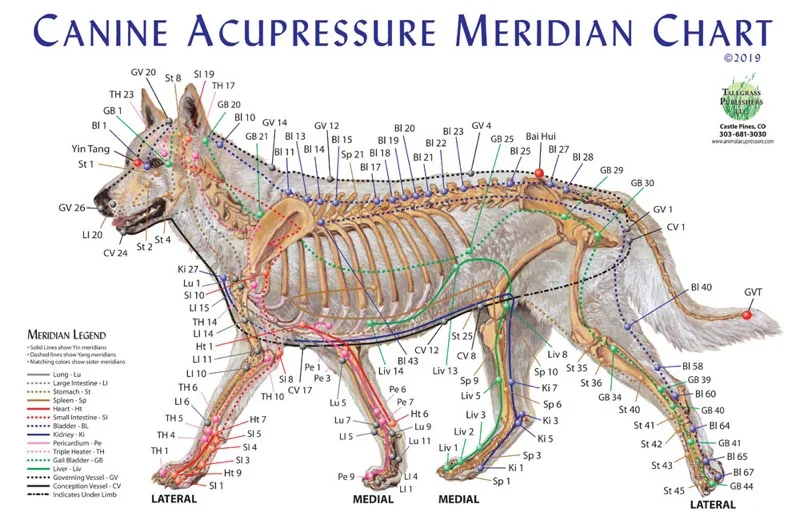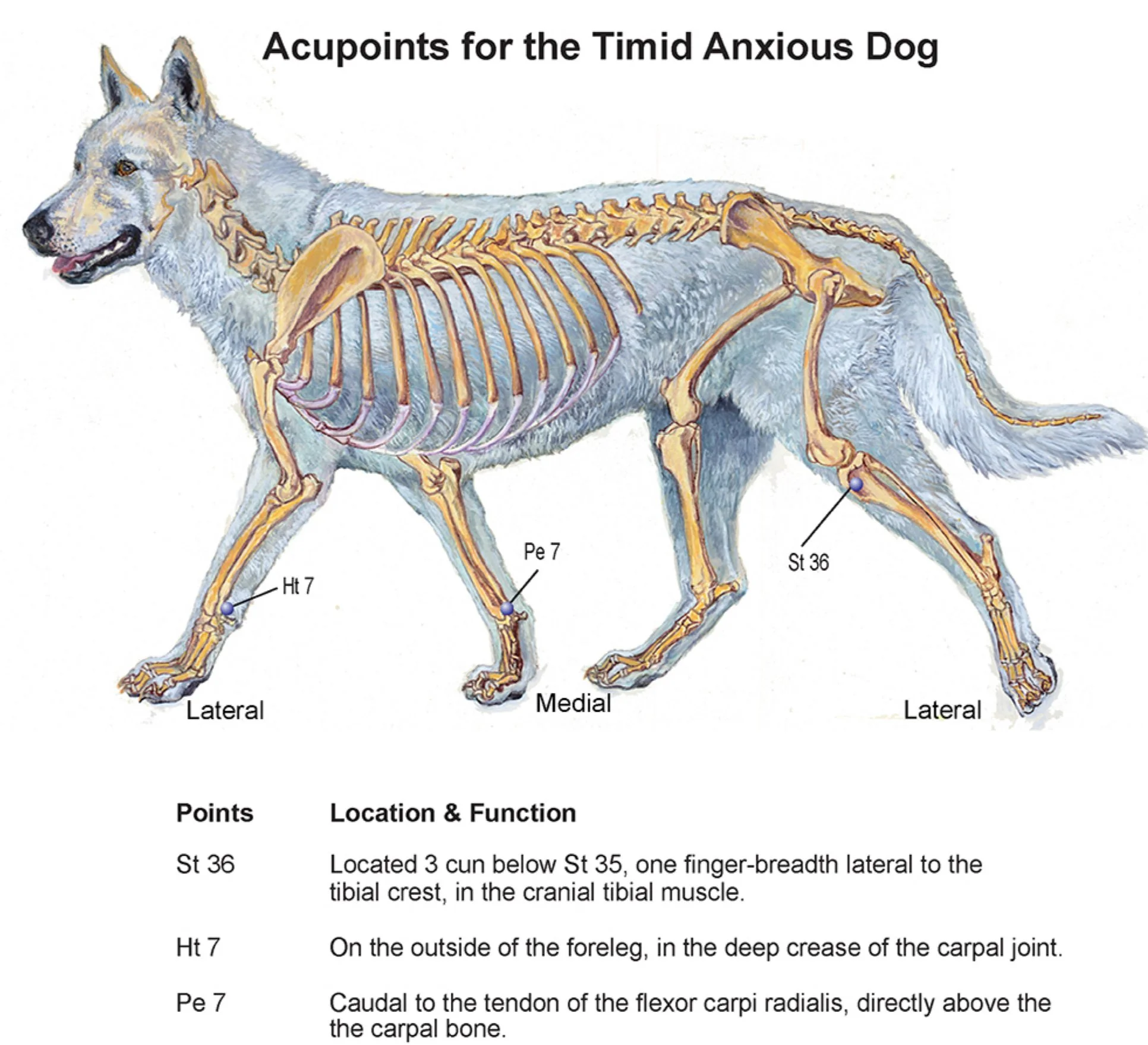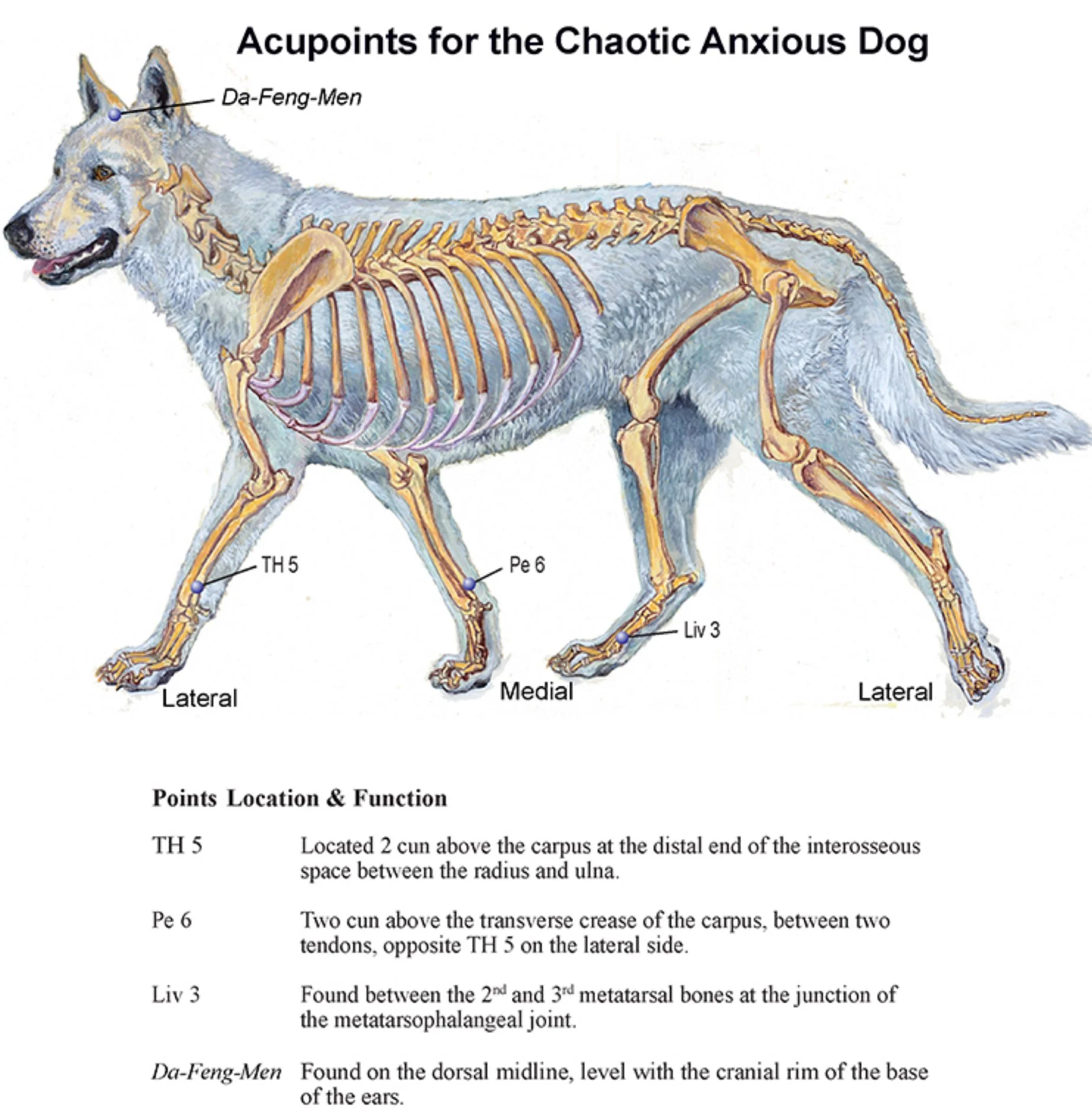The Healing Touch: Canine Acupressure for Anxiety, Pain Relief, and Whole-Body Wellness at Home
Introduction: Gentle Touch for Your Dog’s Health
Watching your dog struggle with anxiety, joint pain, or stiffness can be heartbreaking. As a devoted pet parent, you want to help in a safe, effective, and gentle way. One therapy you can practice at home is canine acupressure.
Canine acupressure is based on Traditional Chinese Veterinary Medicine (TCVM). It involves using your hands to apply gentle pressure to specific points on your dog’s body. These points support natural energy flow, help reduce pain, improve mobility, and calm anxiety. Unlike acupuncture, acupressure does not use needles, making it safe, easy, and perfect for at-home wellness care.
This guide explains how canine acupressure works, the science behind it, and how you can use it to improve your dog’s emotional and physical health.
What Is Canine Acupressure and How Does It Work?
Acupressure has been used in animals for centuries. It focuses on acupoints, specific locations on the body along energy pathways called meridians. In TCVM, energy, or Qi, flows through these meridians. When energy flow is blocked, it can lead to pain, anxiety, digestive problems, or other health issues.
Applying pressure to acupoints stimulates the flow of energy and blood. This can help your dog feel calmer, relieve discomfort, and support overall health.
How Acupressure Helps Your Dog
There is strong evidence that acupressure has measurable effects on dogs’ health. Some of the benefits include:
Better circulation: Improves blood flow, delivers nutrients, and helps remove toxins.
Pain relief: Triggers the release of natural pain-relieving chemicals such as endorphins.
Emotional calm: Promotes serotonin and oxytocin release, helping your dog feel relaxed and happy.
Studies show acupuncture, which uses the same points, can reduce pain and improve mobility in 78 to 84% of dogs with arthritis and chronic musculoskeletal issues. This suggests acupressure can offer similar benefits when practiced at home.
How to Practice Canine Acupressure at Home
Create a Calm Environment
Choose a quiet space where your dog feels safe. Sessions can last from five to twenty minutes. Treat this time as a special bonding moment rather than a treatment chore.
Basic Techniques
Acupressure is performed using the thumb or the first and second fingers, with the second finger resting gently over the first to provide stability and control. Before beginning, it’s beneficial for the guardian to take a few slow, deep breaths to ensure both human and dog are in a calm, balanced state—this helps enhance energetic connection and sensitivity to subtle changes.
Begin by tracing along the Bladder meridian, located on either side of the spine. This meridian is unique in that it connects with all eleven of the other major meridians, acting as an energetic highway for the body. Performing this opening stroke three times not only helps balance energy flow but also allows the practitioner to sense temperature changes or areas of tension—often experienced as warmth, tightness, or energetic shifts beneath the fingers.
Acupressure can be applied with gentle, steady pressure or through slow circular motion (“circular friction”)—always adapting to the dog’s comfort and responses.
Slow circular motions
Linear friction: Smooth strokes along the neck, back, and shoulders.
Circular friction: Gentle circles over the head, temples, or around joints.
The Hold
Place gentle pressure on a specific acupoint until you feel slight resistance.
Hold for five to ten seconds, adjusting the pressure to your dog’s comfort level.
Reading Your Dog’s Signals
Pay attention to your dog’s reactions. Signs of relaxation include soft eyes, deep breathing, yawning, rolling over, or licking you. Signs your dog is uncomfortable include pulling away, stiff muscles, or ear tension. Always respect these signals and adjust pressure accordingly.
Canine Acupressure for Anxiety and Stress
Many dogs experience anxiety from separation, loud noises, or changes in routine. Acupressure can help calm your dog and reduce stress.
Understanding Anxiety in Dogs
In TCVM, anxiety can be caused by imbalances in the Heart (Fire element) and Kidney (Water element). Heart Fire governs mental activity and spirit, while Kidney Water helps calm and balance this energy. Stress can also cause Liver Qi stagnation, leading to tension and overexcited behavior.
Acupressure supports emotional balance by calming the spirit, restoring energy flow, and helping your dog feel safe and relaxed.
Top Acupoints for Anxiety
Please note all images are owned and copyrighted to Tallgrass Animal Acupressure Institute ©️
Pro tip: Do not attempt acupressure during intense fear triggers like thunderstorms. First, move your dog to a calm, quiet space
When working with dogs experiencing anxiety, stress, or fear, several key acupoints are particularly valuable. These include GV20 (Bai Hui) at the crown of the head, GV14, BL23, and Bai Hui (the “eight meeting point” located in the small dimple between the hips). Additionally, Ki27 and Ki1—which are part of the Kidney meridian—help to ground and calm, addressing the root of fear that often stems from Kidney imbalance in Traditional Chinese Medicine (TCM).
For emotional regulation, Ht7 (Heart 7) and PC6 (Pericardium 6) are excellent for reducing stress and promoting calmness, while Yin Tang, located between the eyes, can aid in relaxation and mental clarity.
Less Is Often More in Canine Acupressure
When you first look at acupressure charts, it can be easy to feel overwhelmed by how many points are shown. The truth is, you don’t need to use them all. Even using one or two specific points can have a powerful effect on your dog’s wellbeing. Every dog is unique, and acupressure works best when it’s tailored to your individual dog’s needs and responses.
For example, when speaking with Kimberly Peri of “In Harmony Integrated Wellness“who is a qualified and certified Tallgrass Animal Acupressure Institute practitioner and Traditional Chinese Medicine (TCM) expert, she explained that for the chart immediately above, labelled “Points for the Chaotic, Anxious Dog,” she would only use PC6 (Pericardium 6) instead of all four points shown. By focusing on fewer points, the session remains calm, balanced, and effective without overstimulating your dog’s energy system.
When practising acupressure for dogs, always aim for quality over quantity. Choosing the right point, applied gently and mindfully, can support relaxation, reduce anxiety, and help restore balance far more effectively than using too many points at once.
Pain Relief and Support for Chronic Conditions
Acupressure is especially effective for dogs with arthritis, hip dysplasia, or other musculoskeletal conditions. It can:
Reduce pain naturally through endorphin release
Improve mobility and comfort
Potentially reduce reliance on medication, supporting long-term organ health
Key Points for Physical Support
BL40 (Back of Knee): Reduces inflammation and supports joint comfort
LU1 (Chest/Upper Lung): Supports respiratory function
ST36 (Below Knee): Promotes digestion and energy
Regular acupressure can help your dog recover faster from surgery, reduce inflammation, and support overall organ function.
Watch and Learn: Dr Jones’ Acupressure Video for Dogs
If you’re a visual learner or want a step-by-step demonstration of key acupressure points, we highly recommend the YouTube video by Dr Jones titled “Acupressure for Common Dog Health Problems”.
In this video, Dr Jones walks you through practical application of gentle acupressure techniques, clearly showing how to locate and stimulate spots such as PC6 (Pericardium 6) and Ki1 (Kidney 1) in a calm, controlled manner.
By seeing real-life demonstrations, you’ll gain confidence in your own hands-on technique and be better able to follow safe, effective practice at home.
Kidney Imbalance and Fear
In TCM, the Kidney meridian is associated with the Water element, which governs both physical and emotional balance. When the Kidney system becomes imbalanced—often due to chronic stress, age, or trauma—it can manifest as fear, anxiety, or insecurity. Supporting the Kidney meridian through acupoints such as Ki1 (Yong Quan) and Ki27 (Shu Fu) can help restore a sense of grounding and calm. This approach aligns beautifully with the holistic goal of acupressure: balancing the body’s internal energy systems to promote emotional and physical harmony.
How Acupressure Differs from Acupuncture and Canine Massage
At first glance, acupressure, acupuncture, and canine massage may seem quite similar after all, each involves touch, relaxation, and physical connection. Yet, while they share some therapeutic overlap, the intent, technique, and depth of influence within the body are quite distinct. Understanding these differences can help you choose the most suitable modality for your dog’s needs.
Acupressure: Energy Pathways and Gentle Stimulation
Acupressure is a needle-free form of Traditional Chinese Medicine (TCM) that uses gentle, sustained pressure on specific points — known as acupoints — along the body’s energy channels, or meridians. The goal is to restore balance and support the body’s natural healing ability.
When pressure is applied to these points, it’s believed to influence the flow of Qi (vital energy) and improve communication between organ systems. In modern terms, acupressure has been shown to stimulate nerve endings, increase endorphin release, improve circulation, and support relaxation and pain modulation.
Research suggests that acupressure can activate the parasympathetic nervous system — the body’s “rest and digest” mode — helping to reduce stress, lower heart rate, and ease muscle tension. For dogs, this can be especially beneficial for anxiety, chronic pain, or age-related stiffness.
Acupuncture: Precision with Needles
Acupuncture shares the same theoretical foundation as acupressure — the stimulation of energy flow through meridians — but instead of using fingers, a qualified veterinary acupuncturist inserts fine sterile needles into specific acupoints.
Because needles penetrate deeper tissue layers, acupuncture tends to have a stronger physiological effect. It can trigger measurable changes in the body’s biochemistry, including the release of endorphins, serotonin, and anti-inflammatory cytokines.
For this reason, acupuncture is often recommended for more complex or chronic conditions such as arthritis, neurological issues, or organ imbalances. It should always be performed by a licensed veterinarian trained in acupuncture — many of whom are graduates of institutions like the Chi University or IVAS (International Veterinary Acupuncture Society).
Canine Massage: Muscular and Structural Focus
Massage therapy, while it may sometimes overlap with acupressure points, primarily targets the muscles, fascia, and soft tissues. It’s designed to improve circulation, reduce stiffness, enhance lymphatic drainage, and promote relaxation through mechanical manipulation rather than energetic balancing.
Massage is particularly effective for improving mobility, aiding recovery after exercise or injury, and maintaining muscle tone in active or senior dogs. However, it does not aim to influence meridian energy or organ systems directly, as acupressure and acupuncture do.
In Summary
Think of it this way:
• Acupressure uses gentle touch to stimulate energy flow and balance internal systems.
• Acupuncture uses needles for deeper, more targeted energetic and physiological effects.
• Massage focuses on physical structures — muscles and tissues — to improve comfort and flexibility.
Together, these modalities complement one another beautifully. Acupressure sits at the intersection between body and energy — bridging science and intuition — and can easily be practiced at home to support your dog’s wellbeing between professional treatments.
Safety and Professional Guidance
When to Avoid Acupressure
Do not use acupressure on dogs who are:
Pregnant
Experiencing bleeding disorders
Feverish or with infectious diseases
With pacemakers or other electrical implants
Showing undiagnosed lumps or tumours
Signs of Discomfort
If your dog vocalises, stiffens muscles, or tries to move away, reduce pressure or stop the session. Never force acupressure.
Working With a Veterinarian
The foundational principles of this approach are taught by several leading schools of Traditional Chinese Veterinary Medicine, including the Chi Institute, the Northwest School of Animal Massage, and Ojai School of Massage, each contributing to the advancement of integrative animal therapies.
With gratitude to practitioners like Dr. Josie Beug DVM who studied through the Chi Institute, and to experts dedicated to blending science and energy-based healing.
For proactive care, further learning or consultation, seek help from an appropriately qualified canine acupressure practitioner, Like our TBC group moderator and good friend, Kimberly Peri of “In Harmony Integrated Wellness“who is a qualified and certified Tallgrass Animal Acupressure Institute practitioner based in Phoenix, Arizona.
For chronic or complex conditions, consult a Certified Veterinary Acupuncturist (CVA) like Dr. Josie Beug DVM. A qualified vet with the additional TCM approaches can create a personalised plan while teaching safe home techniques for complex or sick dogs.
Most dogs show improvement within four to six sessions. Once they feel more comfortable, monthly maintenance sessions can help sustain mobility and emotional balance.
Acupressure in research
There is growing scientific support for acupressure and related Acupoint-based therapies in canine health care. Clinical studies demonstrate that stimulating specific acupoints—whether by pressure or fine needles—can modulate the nervous system, improve circulation, and trigger the release of endogenous opioids and neurotransmitters, leading to reduced pain and inflammation and enhanced mobility. A 2020 randomised, placebo-controlled clinical trial found acupuncture significantly improved lameness and function in dogs with osteoarthritis (Baker-Meuten et al., 2020).
Similarly, a therapeutic trial on 47 dogs with musculoskeletal and spinal issues reported statistically significant improvements in mobility and comfort following combined acupuncture and manual therapy (March et al., 2015). Reviews of veterinary acupuncture research confirm that acupoint stimulation can modulate both peripheral and central nervous systems, enhance immune function, and promote healing (Dewey & Xie, 2021).
A 2023 retrospective study of 94 dogs with intervertebral disc herniation also demonstrated notable recovery rates (up to 85%) with acupuncture intervention (Xie et al., 2023).
Although most research has focused on acupuncture rather than manual acupressure, both modalities stimulate the same meridians and pressure points. As such, acupressure—being non-invasive and safe when applied correctly—offers a practical, stress-reducing way for guardians to support pain management, relaxation, and overall wellbeing in dogs as part of a holistic care plan (VCA Animal Hospitals, n.d.; Whole Dog Journal, n.d.).
1. Baker-Meuten A. et al. (2020) – Evaluation of acupuncture for the treatment of pain associated with naturally-occurring osteoarthritis in dogs: a prospective, randomized, placebo-controlled, blinded clinical trial. BMC Veterinary Research
2. Dewey C.W. & Xie H. (2021) – The scientific basis of acupuncture for veterinary pain management: a review based on relevant literature from the last two decades. Open Veterinary Journal
3. March J. et al. (2015) – Effectiveness of combined acupuncture and manual therapy (CAMT) relative to exercise restriction in dogs with spinal and musculoskeletal conditions. PM & R Journal
4. Xie H. et al. (2023) – Retrospective study of acupuncture treatment for canine thoracolumbar intervertebral disc herniation (TL-IVDH). One Health Advances
5. VCA Animal Hospitals (n.d.) – Acupuncture / Acupressure for Dogs. VCA Hospitals Knowledgebase
6. Whole Dog Journal (n.d.) – Canine Massage, Acupressure and TTouch. Whole Dog Journal
Conclusion: Empower Your Dog’s Health Through Touch
Canine acupressure is a gentle, safe, and evidence-backed way to support your dog’s physical and emotional wellbeing. By practicing mindful touch and targeting key acupoints, you can help your dog:
Reduce anxiety and stress
Relieve pain and improve mobility
Support long-term health and vitality
Regular acupressure strengthens your bond with your dog and provides daily support for a happier, healthier life.
Want to Learn More?
If you’d like to explore canine acupressure further, there are some fantastic educational resources created by leading experts in the field:
• The Tallgrass Animal Acupressure Institute offers webinars and practitioner courses for anyone interested in deepening their understanding of Traditional Chinese Veterinary Medicine (TCVM).
• The classic guide Acu-Dog Book and CD is a must-have for anyone wanting a structured introduction to at-home acupressure techniques.
• The Ojai School of Massage provides a helpful canine acupuncture point chart for students and dog guardians alike.
• You can also watch retired veterinarian Dr. Allen Schoen’s Acupressure for Animals for practical demonstrations.
• For those interested in more advanced study, explore Dr. Roswitha Boston’s Ear Meridian Maps and the AJTCVM anatomical reviews, which delve into the scientific detail behind these ancient technique





